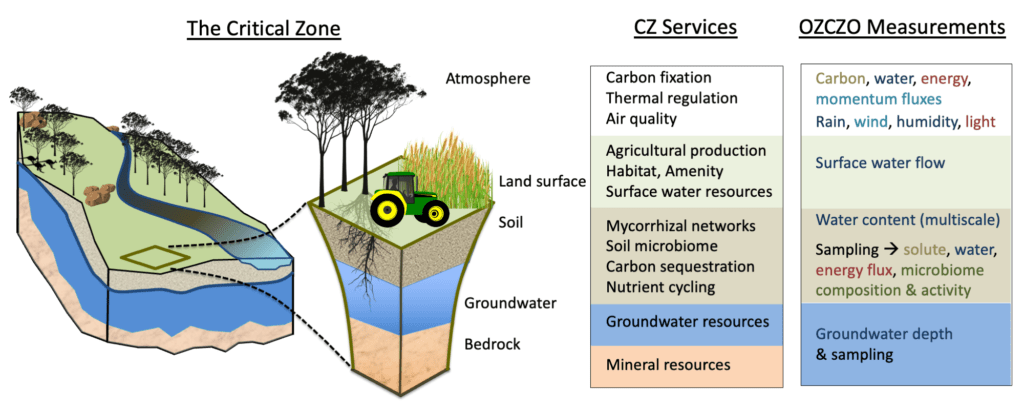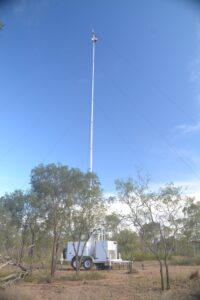A consortium of Australian universities has secured $1.2M of Australian Government funding to help create a network of Critical Zone Observatories (CZO) across Australia. The funding will enable research into Australia’s outer skin—from treetop to bedrock, where water, atmosphere, ecosystems, soil and rock interact—to better understand and manage the availability of its life-sustaining resources.
The funding—part of the Australian Research Council’s Large Infrastructure, Equipment and Facilities scheme (ARC LIEF)—will create a new network of five core and five satellite monitoring sites in five states, sampling a diversity of Australia’s geologies, biomes, land uses and climates.
State-of-the-art, automated environmental monitoring infrastructure at the sites will observe stocks and flows of carbon, water, energy and mass across the Critical Zone—the vertical span from plant canopies to fresh bedrock.
The information collected will fill essential knowledge gaps about interactions of under- and above-ground environmental processes and their responses to disturbance and change. These interactions determine the sustainability of food, clean water, mineral resources and Australian ecosystems, and cannot be studied with existing environmental infrastructure.
The funding will also support the development of a robust, long-term strategy for more effective and collaborative Critical Zone science, helping catalyse Critical Zone science in Australia and joining a burgeoning international movement.
Collaboration and co-location
The Australian CZO network (OZCZO) will be collaboratively developed and managed by a team of researchers from the University of Western Australia, the University of Adelaide, the University of the Sunshine Coast, James Cook University and the University of New South Wales.
The NCRIS-funded national research infrastructure projects of TERN, AuScope and Groundwater will also play leading roles in building and operating the network’s monitoring infrastructure. TERN is not only associated with six of the ten CZO sites and data but will also make OZCZO data openly available via the TERN data portal.
The initiative adds critical monitoring capabilities missing from existing observation networks, like NCRIS-enabled TERN and the SmartSat CRC’s Earth Monitoring Capability, including soil dynamics, root zones and hydro- and biomantles; and integrated processes between the above- and below-ground components of the Critical Zone.

Illustration of OZCZO below-ground and terrestrial CZ observational instrumentation. The mix of pre-existing and new instrumentation shown here is applicable to the OZCZO core sites that are also TERN sites (Fletcherview and Calperum).
Answering life sustaining questions
Associate Professor Sally Thompson of the University of Western Australia is the lead researcher on the project and says that the national investment will complement Australia’s existing ecosystem observational capacity, enabling and supporting new, transdisciplinary science that integrates geology, pedology, geochemistry, hydrology, biology, ecology and atmospheric sciences.
“The new infrastructure will let us unify our understanding of surface and subsurface environments and how they co-evolve and influence each other.
This understanding is crucial to answering the pressing question: how can Australia’s Critical Zone keep providing life-sustaining services like food, water, energy and minerals, to our growing population in a changing climate without risking the integrity of Critical Zone functions and the ecosystems they support?”
Associate Professor Sally Thompson, University of Western Australia
- The OZCZO team is Associate Professor Sally Thompson; Professor David Chittleborough; Dr Juraj Farkas; Professor Jason Beringer; Dr Andrew Marshall; Dr Jamie Cleverly; Professor Wayne Meyer; Associate Professor Martin Andersen; Dr Matthias Leopold; and Dr Martin De Kauwe.
- The ARC LIEF CZO project has already attracted additional funds via an AuScope Opportunity Fund (AOF) for a two-year project called ‘Laying the foundations for the Australian Critical Zone Observatories’ in which Electric Resistivity Tomography (ERT) and Seismic Refraction (SR) will be deployed at the five core CZO sites across Australia. At each, the aim is to determine (i) Depth to bedrock, (ii) Water table depth, (iii) Sedimentologic layering, and (iv) Characteristics of the weathering profile.
- OZCZO is being built as community infrastructure. Researchers are encouraged to use the infrastructure and the data streams being collected to support cross-site, cross-domain science. The OZCZO team would love to discuss ideas with you and support research proposals with access to OZCZO infrastructure.

The critical zone stretches vertically from bedrock to the atmospheric boundary and comprises bedrock, weathered/saprolitic rock, aquifers, soil, the rhizosphere and microbiome in the regolith, habitats, canopies and the nearsurface atmosphere. The CZ provides numerous life-supporting services. OZCZO will enable the integration of understanding across CZ zones, by measuring dynamics relating to water (blue), energy (red), mass (brown), and biotic processes (green).










